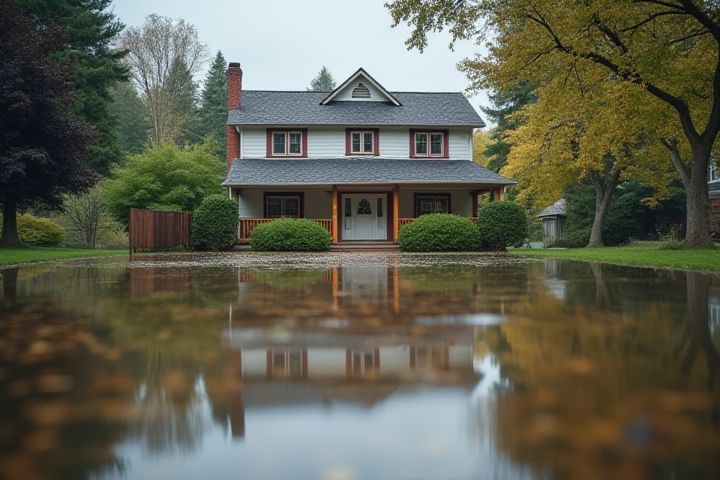
When your house floods, first ensure everyone's safety by evacuating to higher ground and avoiding contact with floodwater due to potential contaminants. Next, contact your local emergency services to report the flooding and get assistance if necessary. Once the area is safe, turn off electricity and gas to prevent hazards, and document the damage with photos for insurance claims. Begin removing standing water promptly using a sump pump or buckets, and start drying out your home with fans and dehumidifiers to prevent mold growth. Finally, seek help from restoration professionals to assess structural damage and facilitate repairs, ensuring your home is safe and secure before returning.
What To Do If House Floods
Ensure safety by shutting off electricity and gas.
In the event of a house flood, prioritize your safety by immediately shutting off the electricity at the main breaker to prevent potential electrocution hazards. Next, turn off the gas supply to avoid any risk of fire or gas leaks, especially if water has come into contact with your appliances. Ensure you wear protective gear, such as boots and gloves, to avoid contact with contaminated water. After securing utilities, assess the extent of the damage, documenting it with photographs for insurance claims while waiting for professional help.
Evacuate immediately if necessary.
If your house experiences flooding, prioritize your safety by evacuating immediately, especially if water levels rise rapidly or if you hear alarms. Before leaving, turn off utilities at the main switch, disconnect electrical appliances, and avoid walking through moving water, as it can be deeper and more dangerous than it appears. Navigate to higher ground and seek emergency shelters if available, ensuring you stay updated on local evacuation routes through official sources. After the immediate danger has passed, document any damages for insurance purposes and follow local guidelines for returning to your home safely.
Contact emergency services for assistance.
In the event of a house flood, promptly contact emergency services for immediate assistance to ensure your safety. They can provide expert guidance, assess the situation, and coordinate rescue efforts if needed. Make sure to document the damage with photographs for insurance claims, as this will facilitate faster processing. After securing your safety and contacting professionals, you should also reach out to your insurance provider to report the incident and discuss coverage options for damages.
Document the damage with photos and videos.
Documenting flood damage promptly is crucial for insurance claims and restoration efforts. Capture clear photos and videos of affected areas, focusing on structural damage, damaged belongings, and standing water levels. Ensure you take images from multiple angles and include relevant timestamps to provide a comprehensive view of the aftermath. These documented evidence pieces will support your claims, resulting in more efficient recovery and compensation.
Notify your insurance company promptly.
Notify your insurance company promptly after experiencing flooding in your home, as this is crucial for initiating the claims process. Document the damage thoroughly by taking photographs and making a list of affected items, which can expedite your claim. Familiarize yourself with your policy limits and coverage specifics to ensure that you receive adequate compensation for repairs and lost belongings. Remember, swift communication with your insurer can significantly influence your recovery timeline and overall financial support.
Salvage important belongings and documents.
To salvage important belongings and documents after a house flood, immediately prioritize recovery efforts to minimize damage. Start by wearing protective gear, like gloves and boots, to ensure safety while navigating flooded areas. Identify essential items, such as family heirlooms, financial documents, and electronics, and carefully remove them from the water if they are not submerged. For important documents, consider using a vacuum freeze dryer or placing them in a freezer to prevent mold while you figure out restoration options.
Begin water removal and drying processes.
Begin the water removal process by using a combination of pumps, wet vacuums, and towels to extract as much standing water as possible from your home. Ensure your safety by turning off electricity in affected areas and wearing appropriate protective gear. Once the majority of the water is removed, initiate the drying process by opening windows and doors, using fans, and dehumidifiers to circulate air and reduce moisture levels. Monitor the drying progress carefully, as it is essential to prevent mold growth and restore your home effectively.
Prevent mold by ventilating affected areas.
To prevent mold growth after a house flood, prioritize proper ventilation in affected areas. Open windows and doors to promote airflow, and use fans and dehumidifiers to reduce moisture levels. If possible, remove soaked materials such as carpets and furniture to facilitate drying. Regularly monitor humidity levels with a hygrometer to ensure the environment stays dry, ideally between 30% and 50%.
Dispose of contaminated items appropriately.
After a flood, contaminated items such as carpets, furniture, and personal belongings should be disposed of properly to prevent health risks. Ensure that you wear protective gear, including gloves and masks, to avoid exposure to dangerous substances. Check local regulations for hazardous waste disposal guidelines, as many municipalities have specific protocols for disposing of flood-damaged materials. Document the damaged items for insurance claims, taking photographs before disposal to accurately represent your losses.
Seek professional restoration services.
In the event of flooding, seeking professional restoration services is crucial to mitigate damage effectively. Experts are equipped with specialized tools such as water extraction equipment and dehumidifiers, which can remove excess moisture and prevent mold growth within 24 to 48 hours. Prompt action enhances the chance of restoring affected areas, preserving structural integrity, and reducing repair costs, which can skyrocket without timely intervention. Always verify that the restoration company is certified and has experience in handling flood situations to ensure quality service.
